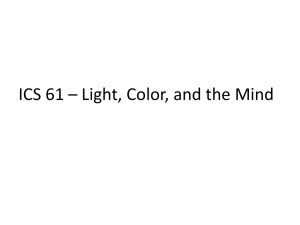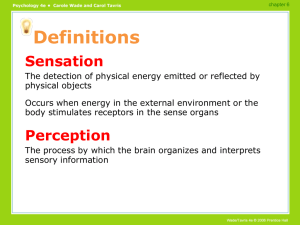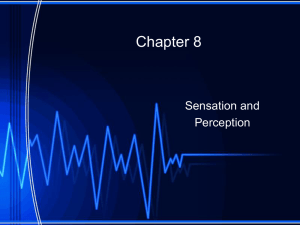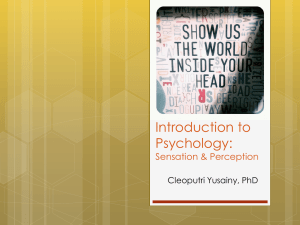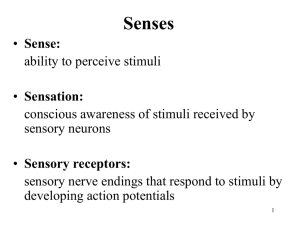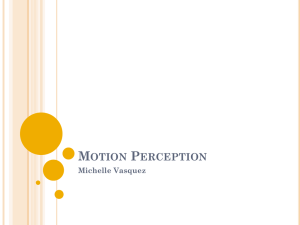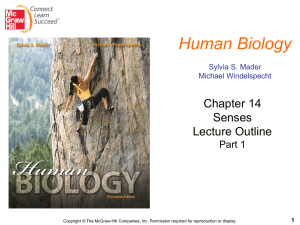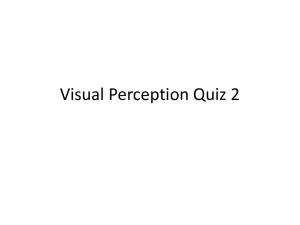Sensation and Perception
advertisement
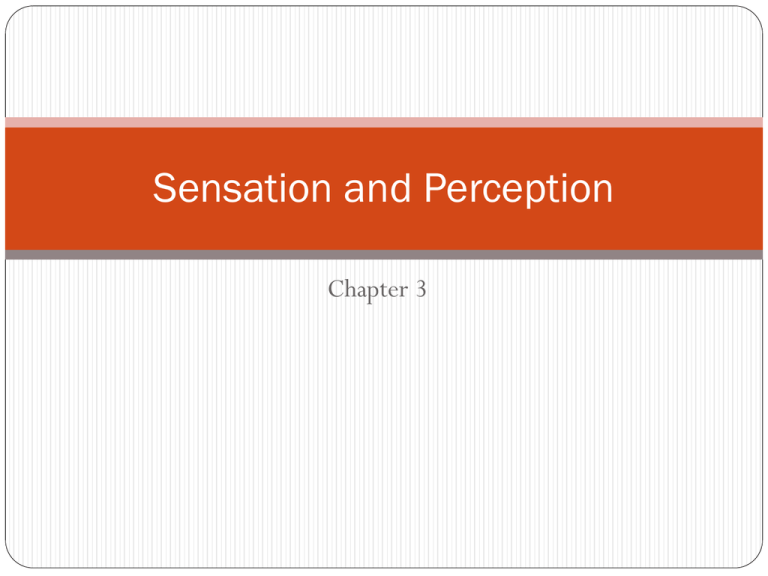
Sensation and Perception Chapter 3 What is sensation? Sensation allows us to receive information from the world around us Information flowing in from the environment makes its way to the brain through our sensory organs i.e. eyes, ears, nose, skin, and taste buds Sensation occurs when special receptors in the sense organs are activated, allowing various forms of outside stimuli to become neural signals in the brain Transduction – the process of converting outside stimuli, such as light or sound, into neural activity Sensory Receptors Sensory receptors – specialized forms of neurons Instead of receiving neurotransmitters from other cells, these receptor cells are stimulated by different kinds of energy Ex. Receptors in the eyes are stimulated by light receptors in the ears are activated by sound vibrations Touch receptors are stimulated by pressure or temperature Receptors for taste and smell are triggered by chemical substances Sensory Thresholds Ernst Weber – conducted studies trying to determine the smallest difference between two weights that could be detected Led to formulation of Weber’s Law of Just Noticeable Differences (jnd) or difference threshold Jnd – the smallest difference between two stimuli that is detectable 50% of the time Weber’s law simply means that whatever the difference between stimuli might be, it is always a constant Ex.You have a cup of coffee containing 5 teaspoons of sugar If to notice a difference in the amount of sugar in the coffee you have to add another teaspoon, then the percentage of change needed to detect a just noticeable difference is 1/5 or 20% So if a cup of coffee has 10 teaspoons of sugar in it, you would have to add another 20%, or 2 more teaspoons, to be able to taste the difference half of the time Sensory Thresholds Gustav Fechner – expanded Weber’s ideas, came up with the absolute threshold The lowest level of stimulation that a person can consciously detect 50% of the time the stimulation is present Ex. Assuming an individual possesses normal hearing ability, when placed in a very quiet room, how far away can someone sit and he/she might still hear the tick of their watch half of the time Sense Threshold Sight A candle flame at 30 miles on a clear, dark night Hearing The tick of a watch 20 feet away in a quiet room Smell One drop of perfume diffused throughout a 3-room apartment Taste 1 teaspoon of sugar in 2 gallons of water Touch A bee’s wing falling on the cheek from 1 centimeter above Subliminal Perception? Stimuli that are below the level of conscious awareness are called subliminal stimuli These stimuli are just strong enough to activate the sensory receptors but not strong enough for people to be consciously aware of them Many people believe that these stimuli act upon the unconscious mind, influencing behavior in a process called subliminal perception Many researchers have gathered scientific evidence that subliminal perception does not work in advertising Contrary to popular belief…. Actual Subliminal Perception Although research suggests subliminal perception does not work in advertising, that doesn’t mean it does not exist A growing body of evidence suggests that we process some stimuli without conscious awareness Especially stimuli that are fearful or threatening Using event-related potentials (ERPs) and functional magnetic resonance imaging (fMRI) researchers have verified the existence of subliminal perception and associated learning in the laboratory These studies use stimuli that are above the sensory threshold but below the level of conscious awareness These stimuli typically influence automatic reactions (ex. Tensing of the facial muscles) rather than direct voluntary behaviors (ex. Going out and purchasing a product) Habituation and Sensory Adaptation Lower centers of the brain filter sensory stimulation and “ignore” or prevent conscious attention to stimuli that do not change The brain is only interested in changes in information Ex. This is why people usually don’t notice the hum of an air conditioner or hear noises in a classroom until it gets very quiet Although people are actually hearing the noises (hum of the air conditioner) they aren’t paying attention to it, this is called habituation Habituation – tendency of the brain to stop attending to constant, unchanging information Habituation and Sensory Adaptation Another process by which constant, unchanging information from the sensory receptors is effectively ignored is sensory adaptation Sensory adaptation – tendency of sensory receptor cells to become less responsive to a stimulus that is unchanging Ex. When you first come into your house, you smell the odor of the garbage can in the kitchen, but after a while the smell seems to go away Ex. When you eat, the food you put in your mouth tastes strong at first, but as you keep eating the same thing, the taste somewhat fades Different from habituation Habituation: sensory receptors are still responding to stimulation but the lower centers of the brain are not sending the signals from those receptors to the cortex Sensory adaptation: the receptor cells themselves become less responsive to an unchanging stimulus and the receptors no longer send signals to the brain Smell, taste, and touch are all subject to sensory adaptation Sensory Adaptation and Vision Does sensory adaptation occur for visual stimuli? If you stare at something long enough, will it disappear? NO The eyes are different Even though the sensory receptors in the back of the eyes adapt to and become less responsive to a constant visual stimulus, under ordinary circumstances the eyes are never entirely still There is a constant movement of the eyes, tiny vibrations called saccadic movements that people don’t consciously notice http://www.youtube.com/watch?v=Ig76-rzPkc8 These movements keep the eyes from adapting to what they see Good thing, because otherwise a lot of students would probably go blind from staring off into space… Perceptual Properties of Light: Catching the Waves Light actually consists of tiny “packets” of waves called photons Photons have specific wavelengths 3 aspects of our perception of light Brightness: determined by the amplitude of the wave (how high or low the wave actually is) Higher the wave the brighter the light appears to be Color: largely determined by the length of the wave Long wavelengths are found at the red end of the visible spectrum (the portion of the whole spectrum of light that is visible to the human eye) Shorter wavelengths are found at the blue end Saturation: the purity of the color people perceive A highly saturated red (or blue) would contain only red (or blue) wavelengths Ex. When a child is using the red paint from a set of poster paints, the paint on the paper will look like a pure red, but if the child mixes in some white paint, the paint will look pink. Hue is still red but it is less saturated because of the white wavelengths From Front to Back: The Parts of the Eye What happens to an image being viewed as the photons of light from that image travel through the eye? Light enters the eye directly from a source (ex. The sun) or indirectly by reflecting off of an object To see clearly, a single point of light from a source or reflected from an object must travel through the structures of the eye and land on the retina as a single point Light bends as it passes through substances of different densities, through a process called refraction Ex. When looking at a drinking straw in a glass of water from the side of the glass, the straw appears to be bent From Front to Back: The Parts of the Eye The surface of the eye is covered in a clear membrane called the cornea Cornea protects the eye and also focuses most of the light coming into the eye Cornea has a fixed curvature, like a camera From Front to Back: The Parts of the Eye Past the cornea, the next layer is a clear, watery fluid called the aqueous humor This fluid is continually replenished and supplies nourishment to the eye Light from a visual image then enters the interior of the eye through a hole, called the pupil, in a round muscle called the iris (the colored part of the eye) The iris can change the size of the pupil, letting more or less light into the eye This also helps focus the image; people try to do the same thing by squinting From Front to Back: The Parts of the Eye Behind the iris, is the lens, which is suspended by muscles The lens finishes the focusing process begun by the cornea Visual accommodation – the lens changes its shape from thick to thin, enabling it to focus on objects that are close or far away Variation in thickness allows the lens to project a sharp image on the retina People lose this ability as the lens hardens through aging Past the lens, light passes through a large, open space filled with a clear, jelly-like fluid called the vitreous humor This fluid, like the aqueous humor, also nourishes the eye and gives it shape Retina, Rods, and Cones The final stop for light within the eye is the retina, a light-sensitive area at the back of the eye 3 areas of the retina Rods and cones – special cells that respond to the various light waves part that actually receives the photons of light and turns them into neural signals to the brain Bipolar cells – type of interneuron that receives neural signals from the rods and cones and sends them to the ganglion cells Ganglion cells – neurons whose axons form the optic nerve, receives neural signals from the bipolar cells The Blind Spot Saccadic movements keep the eyes adapting to constant stimuli But, if people stare with one eye at one spot long enough, objects that slowly cross their visual field may at one point disappear briefly because there is a “hole” in the retina Blind spot – the place where all the axons of those ganglion cells leave the retina to become the optic nerve, insensitive to light There are no rods and cones in the blind spot How the Eye Works: Through the Eyes to the Brain Light entering the eyes can be separated into the left and right visual fields (refer to diagram 3.4, pg. 96 in text) Light from the right visual field falls on the left side of each retina Light from the left visual field falls on the right side of each retina Light travels in a straight line through the cornea and lens This results in the image projected on the retina actually being upside down and reversed from left to right as compared to the visual fields Through the Eyes to the Brain Areas of the retina can be divided into halves Halves toward the temples of the head are called the temporal retinas Halves toward the center, or nose, are called the nasal retinas Information from the left visual field (falling on the right side of each retina) goes directly to the right visual cortex Information from the right visual field (falling on the left side of each retina) goes directly to the left visual cortex Because the axons from the temporal haves of each retina project to the visual cortex on the same side of the brain and the axons from the nasal halves cross over to the opposite side of the brain Optic chiasm – point of cross over Rods & Cones: Different Aspects of Vision Rods: (about 120 million in each eye) found all over the retina except in the very center, which contains only cones Sensitive to brightness but not wavelength So they only see in black & white Very sensitive because many rods are connected to a single bipolar cell, so that if only one rod is stimulated by a photon of light, the brain perceives the whole area of those rods as stimulated (because the brain is receiving the message from the single bipolar cell) But, because the brain doesn’t know exactly which rod is actually sending the message, the visual sharpness is quite low Ex. Things seen in low levels of light, such as twilight or in a dimly lit room, are fuzzy and grayish Rods & Cones: Different Aspects of Vision Because rods are located on the periphery of the retina, they are also responsible for peripheral vision Rods also allow the eyes to adapt to low light Dark adaptation – the recovery of the eye’s sensitivity to visual stimuli in darkness after exposure to bright lights The brighter the light was, the longer it takes the rods to adapt to the new lower levels of light Ex. The bright headlights of an oncoming car can leave a person less able to see for a while after it has passed Full dark adaptation, when going from more constant light to darkness, such as turning out your bedroom lights, takes about 30 minutes Rods & Cones: Different Aspects of Vision Cones: (6 million in each eye) located all over the retina but are more concentrated at its very center called the fovea 50,000 cones have a private line to the optic nerve (one bipolar cell for each cone) This means the cones are the receptors for visual acuity Cones need a lot more light to function than rods do Work best in bright light, which is also when people see things most clearly The cones have to adapt to the increased level of light Light adaptation – the recovery of the eye’s sensitivity to visual stimuli in light after exposure to darkness Occurs much more quickly than the rods adaptation to darkness (a few seconds at most) Cones are sensitive to different wavelengths of light, so they are responsible for color vision Perception of Color: Theories Still unsure about the role cones play in the sensation of color 2 theories originally proposed in the 1800s Trichromatic theory (Young & von Helmholtz) – proposes that there are 3 types of cones: red cones, blue cones, and green cones (one for each primary color of light) Different shades of colors correspond to different amounts of light received by each of these three types of cones These cones then fire their message to the brain’s vision centers It is the combination of cones and the rate at which they are firing that determine the color that will be seen Ex. If the red and green cones are firing in response to a stimulus at fast enough rates, the color the person sees is yellow Perception of Color: Theories In 1964 Brown & Wald identified 3 types of cones in the retina Each sensitive to a range of wavelengths, measured in nanometers, and a peak sensitivity that roughly corresponds to three different colors The peak wavelength of light the cones seem to be most sensitive to is different from Young & von Helmholtz’s original 3 corresponding colors Short wavelength cones detect what we see as blue-violet Medium wavelength cones detect what we see as green Long wavelength cones detect what we see as green-yellow Interestingly, none of the cones identified by Brown & Wald have a peak sensitivity to light where most people see red But, each cone responds to light across a range of wavelengths, not just its wavelength of peak sensitivity Depending on the intensity of the light, both the medium and long wavelength cones respond to light that appears red Perception of Color: Theories The trichromatic theory may seem to be adequate to explain color vision But, there is a phenomenon this theory cannot explain Afterimages – images that occur when a visual sensation persists for a brief time even after the original stimulus is removed Ex. If a person stares at a picture for a while, about a minute, and then looks away to a blank white wall or sheet of paper, that person will see an afterimage of the picture Colors in afterimages do not match the colors in the original image Stare at the white cross for 30 seconds then look at the white wall or a white sheet of paper Perception of Color: Theories Color afterimage is explained by the 2nd theory of color vision Opponent-process theory – proposes that visual neurons (or groups of neurons) are stimulated by light of one color and inhibited by light of another color 4 primary colors: red, green, blue, and yellow Colors are arranged in pairs, red-green and blue-yellow If one color of a pair is strongly stimulated, the other is inhibited and cannot be working Ex. There are no reddish-greens or bluish-yellows Perception of Color: Theories So, how does this color paring theory explain color afterimage? Some neurons (or groups of neurons) are stimulated by light from one part of the visual spectrum and inhibited by light from a different part of the spectrum Ex. A red-green ganglion cell in the retina whose baseline (average) activity is weak when we expose it to white light However, the cell’s activity is increased by red light, so we experience the color red If we stimulate the cell with red light for a long enough period of time, the cell becomes fatigued If we then swap out the red light for a white light, the now-tired cell responds even less than the original baseline and the color green is experienced because green is associated with a decrease in the responsiveness of this cell Exposure to red light red fatigue baseline green Exposure to white light Perception of Color: Theories Both trichromatic theory and opponent-process theory play a part in explaining color vision Trichromatic theory: explains what is happening with raw stimuli, the actual detection of various wavelengths of light Opponent-process theory: explains afterimages and other aspects of visual perception that occur after the initial detection of light Opponent-process cells (the red-green and blue-yellow cells) are also located in the thalamus in an area called the lateral geniculate nucleus (LGN) The LGN is part of the pathway that visual information takes to the occipital lobe When cones in the retina send signals through the retinal bipolar and ganglion cells we see the red versus green parings and blue versus yellow parings Together the retinal cells and the cells in the LGN appear to be the ones responsible for opponent-processing of color vision and the afterimage effect Color Blindness Color blindness or color-deficient vision is caused by defective cones in the retina 3 types of color-deficient vision Monochrome color blindness: very rare, people either have no cones or cones that are not working at all If they have cones, they only have one type and, therefore, everything looks the same to the brain, shades of gray Dichromatic vision: having one cone that does not work properly Protanopia (red-green color deficiency): due to the lack of functioning red cones Deuteranopia (another type of red-green deficiency): due to lack of functioning green cones In both types, the individual confuses reds and greens and sees the world primarily in blues, yellows, and shades of grey Tritanopia (blue-yellow deficiency): less common than dichromatic, results from lack of functioning blue cones Individuals see the world primarily in reds, greens, and shades of gray Color Blindness Only individuals with normal color vision will be able to see the numbers in the circles Color Blindness Why are most people with color-deficient vision men? Color-deficient vision involving one set of cones is inherited via sex-linked inheritance The gene for color-deficient vision is recessive To inherit a recessive trait, you normally need two of the recessive genes, one from each parent But the gene for color-deficient vision is attached to the X chromosome (males = XY, females = XX) The Y chromosome is smaller than the X and has fewer genes One gene the Y chromosome lacks is the one that would suppress the gene for color-deficient vision For a female to have color-deficient vision, she must inherit two recessive genes, one from each parent But, for a male to have color-deficient vision, he only needs to inherit one recessive gene, the one passed on to him on his mother’s X chromosome Perception of Sound: Good Vibrations Sound waves are the vibrations of the molecules of air that surround us Sound waves have similar properties to those of light: wavelength, amplitude, and purity Wavelength: interpreted by the brain as the frequency or pitch (high, medium, or low) of a sound Amplitude: interpreted as volume (how soft or loud a sound is) Timbre: (corresponds to saturation or purity in light) richness in the tone of the sound People are able to hear a limited range of frequencies Frequency is measured in hertz (Hz): cycles (waves) per second Humans limits are between 20 and 20,000 Hz, with the most sensitivity from about 2,000 to 4,000 Hz (very important for conversational speech) Structure of the Ear: Follow the Vibes Outer ear Pinna – the visible, external part of the ear that serves as a kind of concentration, funneling the sound waves from the outside into the structures of the ear Auditory canal – (ear canal) the short tunnel that runs from the pinna down to the tympanic membrane (eardrum) When sound waves hit the eardrum, they cause 3 tiny bones in the middle ear to vibrate Structure of the Ear: Follow the Vibes Middle ear: 3 tiny bones Hammer (malleus) Anvil (incus) Stirrup (stapes) Named for the shapes of the bones The vibration of the these 3 bones amplifies the vibrations from the eardrum The stirrup, the last bone in the chain, causes a membrane covering the opening of the inner ear to vibrate Structure of the Ear: Follow the Vibes Inner ear: membrane called the oval window, its vibrations set off a chain reaction within the inner ear Cochlea: snail-shaped structure making up the inner ear, filled with fluid When the oval window vibrates, it causes the fluid in the cochlea to vibrate, this fluid surrounds a membrane running through the middle of the cochlea called the basilar membrane Basilar Membrane: contains the organ of Corti Organ of Corti – contains the receptor cells for the sense of hearing When the basilar membrane vibrates, it vibrates the organ of Corti, causing it to brush against a membrane above it Special cells called hair cells are the receptors for sound and are located on the organ of Corti When these auditory receptor hair cells are bent up against the other membrane, it causes them to send a neural message through the auditory nerve (which contains the axons of all the receptor neurons) and into the brain, where the auditory cortex will interpret the sounds Transduction – transformation of the vibrations into neural messages The louder the sound in the outside world, the stronger the vibrations that stimulate more of the hair cells, which the brain interprets as loudness http://www.youtube.com/watch?v=7O-adw-HyrQ Perceiving Pitch Pitch – how high or low a sound is 3 primary theories regarding how the brain receives information about pitch Place theory – the pitch a person hears depends on where the hair cells that are stimulated are located on the Organ of Corti Ex. If a person is hearing a high-pitched sound, all the hair cells near the oval window will be stimulated, for a high-pitched sound the hair cells stimulated will be further away on the organ of Corti Frequency theory – pitch is related to how fast the basilar membrane vibrates The faster the membrane vibrates the higher the pitch, the slower it vibrates the lower the pitch In this theory, all the auditory neurons fire at the same time Perceiving Pitch Both place and frequency theory are correct up to a certain point For place theory to be correct, the basilar membrane has to vibrate unevenly (different areas vibrate for different pitches) This is true when the frequency of sound is above 1,000 Hz Correct for moderate to high pitches For frequency theory to be correct, the neurons connected to the hair cells would have to fire as fast as the basilar membrane vibrates This is true with the frequency of a sound is below 1,000 Hz, because neurons don’t appear to fire at exactly the same time and rate when frequencies are faster than 1,000 times per second Correct for low pitches Perceiving Pitch 3rd theory Volley principle – groups of auditory neurons take turns firing in a process called volleying Accounts for pitches from about 400 Hz up to about 4,000 Hz If a person hears a tone of about 3,000 Hz, it means that three groups of neurons have taken turns sending the message to the brain First group for the first 1,000 Hz, second group for the next 1,000 Hz, and so on Types of Hearing Impairments Conduction hearing impairment – sound vibrations cannot be passed from the eardrum to the cochlea Causes include damaged eardrum Bones of the middle ear (usually from an infection) Hearing aids may be able to restore some hearing Types of Hearing Impairments Nerve hearing impairment – problems lies either in the inner ear or in the auditory pathways and cortical areas of the brain Normal aging causes the loss of hair cells in the cochlea, and exposure to loud noises can damage hair cells Tinnitus is the term used to refer to an annoying ringing in the ears and it can be caused by infections or loud noises Because the damage is to the nerves or the brain, this type of impairment cannot be helped with ordinary hearing aids, which are basically sound amplifiers Cochlear implants – a device that sends signals from a microphone worn behind the ear to a sound processor worn on the belt or in a pocket, which then translates those signals into electrical stimuli that are sent to a series of electrodes implanted directly into the cochlea The brain processes the electrode information as sound Chemical Senses: It Tastes Good and Smells Even Better The sense of taste and sense of smell are very closely related Ex. Notice how when your nose is all stopped up, your sense of taste is affected too? This is because the sense of taste is really a combination of taste and smell Without input from the nose, there are actually only four, possibly five, kinds of taste sensors in the mouth Gustation: How We Taste the World – Taste Buds Taste buds – the common name for the taste receptor cells, special kinds of neurons found in the mouth that are responsible for the sense of taste or gustation Most taste buds are located on the tongue, but there are a few on the roof of the mouth, the cheeks, and under the tongue How sensitive people are to various tastes depends on how many taste buds they have Some people have only around 500 and others have about 10,000 (the latter are called “supertasters”… what an odd super power) Contrary to popular belief the “little bumps” on the tongue are called papillae and are not taste buds Taste buds actually line the walls of the papillae Taste Buds Each taste bud has about 20 receptors that are very similar to the receptor sites on receiving neurons at the synapse Receptors on taste buds work exactly like receptor sites on neurons They receive molecules of various substances that fit into the receptor like a key in a lock Taste is called a chemical sense because it works with the molecules of foods people eat in the same way neural receptors work with neurotransmitters When the molecules (dissolved in saliva) fit into the receptors, a signal is fired to the brain, which then interprets the taste sensation http://www.youtube.com/watch?v=FSHGuc gnvLU Gustation: The Five Basic Tastes 4 primary tastes: sweet, sour, salty, and bitter 5th taste – umami Umami receptors detect a pleasant “brothy” taste associated with foods like chicken soup, tuna, kelp, cheese, and soy products Glutamate is the substance that generates the sensation of umami Glutamate is present in the foods mentioned above as well as human breast milk and is also the reason that the seasoning MSG (monosodium glutamate) adds a pleasant flavor to foods The 5 taste sensations work together, along with the sense of smell and the texture, temperature, and “heat” of foods to produce thousands of taste sensations Although researchers once believed that certain tastes were located on certain places on the tongue, it is now known that all of the taste sensations are processed all over the tongue The Sense of Scents: Olfaction Olfaction or olfactory sense – the ability to smell odors Sense of smell is chemical The outer part of the nose serves the same purpose for odors that the pinna and ear canal serve for sounds: both are just ways to collect the sensory information and get it to the part of the body that will translate it into neural signals (transduction) The part of the olfactory system that transduces odors (turns them into neural messages) is located at the top of the nasal passages This area of receptor cells is only about a square inch in each nasal cavity yet contains about 10 million olfactory receptors Olfaction: Receptor Cells Olfactory receptor cells each have about 6-12 little “hairs” called cilia that project into the cavity Like taste buds, there are receptor sites on these hair cells that send signals to the brain when stimulated by the molecules of substances in the air moving past them This means there are actually little particles of what ever you are smelling IN your nose Signals from the olfactory receptors in the nasal cavity do not follow the same path as the signals from all the other senses Vision, hearing, taste, and touch all pass through the thalamus and then on to the area of the cortex that process that particular information Sense of smell has its own special place in the brain – the olfactory bulbs Olfaction: Olfactory Bulbs Located right on top of the sinus cavity on each side of the brain directly beneath the frontal lobes Olfactory receptors send their neural signals directly up to these bulbs, bypassing the thalamus Information is then sent from the olfactory bulbs to higher cortical areas, including the primary olfactory cortex, the orbitofrontal cortex, and the amygdala Somesthetic Senses: What the Body Knows What is thought of as the sense of touch is really several sensations, originating in several different places in and on the body More accurate to refer to these as the body senses or somesthetic senses 3 somesthetic sense systems Skin senses – touch, pressure, temperature, and pain Kinesthetic sense – the location of body parts in relation to each other Vestibular senses – movement and body position Types of Sensory Receptors in the Skin There are around 6 different receptors in the layers of the skin Some respond to only one kind of sensation Ex. Pacinian corpuscles are just beneath the skin and respond to changes in pressure There are nerve endings that wrap around the ends of hair follicles (this is why it hurts to pluck your eyebrows) These nerve endings are sensitive to both pain and touch There are free nerve endings just beneath the uppermost layer of the skin that respond to changes in temperature, pressure, and pain Types of Pain Visceral pain – pain and pressure in the organs Somatic pain – pain sensations in the skin, muscles, tendons, and joints carried on large nerve fibers Body’s warning system that something is being, or is about to be, damaged and tends to be sharp and fast Another type of somatic pain is carried on small nerve fibers and is a slower, more general ache This type of pain acts as a sort of reminder system, keeping people from further injury by reminding them the body has already been damaged Ex. If you hit your thumb with a hammer, the immediate pain sensation is the 1st kind of somatic pain, but the later aching of the bruised tissue reminds you to take it easy on that thumb Abnormalities in Pain Sensation There are people who are born without the ability to feel pain Rare conditions called congenital analgesia and congenital insensitivity to pain with anhidrosis (CIPA) Children with these disorders cannot feel pain when they cut or scrape themselves, leading to an increased risk of infection when the injury goes untreated Theses disorders affect the neural pathways that carry pain, heat, and cold sensations Those with CIPA have additional disruption in the body’s heat-cold sensing perspiration system, so that the person is unable to cool off the body by sweating Phantom limb pain – occurs when a person who has had an arm or leg removed sometimes “feels” pain in the missing limb 50% - 80% of people who have had amputations experience various sensations: burning, shooting pains, or pins-and-needles sensations where the amputated limb used to be Believed to be caused by the traumatic injury to the nerves during amputation http://vimeo.com/52858652 Pain: Gate-Control Theory Suggests that pain signals must pass through a “gate” located in the spinal cord This gate can be closed by nonpain signals coming into the spinal cord from the body and by signals coming from the brain Stimulation of pain receptor cells releases a chemical called substance P (P for pain of course) Substance P released into the spinal cord activates other neurons that send their messages through spinal gates (opened by the pain signal) From the spinal cord, the message goes to the brain, activating cells in the thalamus, somatosensory cortex, areas of the frontal lobes, and the limbic system The brain then interprets the pain information and sends signals that either open the spinal gates farther, causing a greater experience of pain, or close them, lessening the pain Pain: Gate-Control Theory The brain’s decision to either further open or close the “pain gates” is influenced by the psychological aspects of the pain-causing stimulus Anxiety, fear, and helplessness intensify pain Laughter, distraction, and sense of control diminish it This is why people might bruise themselves and not know it if they were concentrating on something else Pain can also be affected by competing signals from other skin senses This is why rubbing a sore spot can reduce the feeling of pain The same psychological aspects can also influence the release of endorphins which is the body’s natural version of morphine Endorphins can inhibit the transmission of pain signals in the brain, and in the spinal cord they can inhibit the release of substance P The Kinesthetic Sense Kinesthesia Special receptors located in the muscles, tendons, and joints are part of the body’s sense of movement and position in space (the location of the arms, legs, and so forth in relation to one another) The special receptors are called proprioceptors They tell you about joint movement or the muscles stretching or contracting This is why when you close your eyes and raise you hand above your head, you know where your hand is The Vestibular Sense: AKA Balance Structures responsible for this sense are located in the innermost chamber of the ear Tell us about the position of the body in relation to the ground and movement of the head 2 kinds of vestibular organs Otolith organs – tiny sacs located just above the cochlea Sacs contain tiny crystals suspended in a gelatin-like fluid (kind of like fruit in a bowl of Jello) As the head moves, the crystals cause the fluid to vibrate, setting off tiny hairlike receptors on the inner surface of the sac This tells the person which direction they are moving Semicircular canals – 3 semicircular tubes that are also filled with fluid and will stimulate hairlike receptors when rotated Having 3 tubes allows one to be located in each of the three planes of motion on which the body can rotate When the body rotates it sets off the receptors in these canals Motion Sickness The vestibular sense is responsible for motion sickness Ex. When you spin around and then stop, the fluid in the horizontal canal is still rotating and will make you feel dizzy because your body is telling you that you are still moving, but your eyes are telling you that you have stopped. This disagreement between what the eyes say and what the body says is what causes motion sickness Motion sickness – the tendency to get nauseated when in a moving vehicle, especially one with irregular movement (like boats) Sensory conflict theory Normally the vestibular sense coordinates with the other senses, but for some people, the information from the eyes may conflict a little too much with the vestibular organs, and dizziness, nausea and disorientation are the result Focusing on a distant point or object provides visual information about how a person is moving, bringing the sensory input into agreement with the visual input, and helping to relieve motion sickness Perception Perception – the method by which the brain takes all the sensations people experience at any given moment and allows them to be interpreted in some meaningful fashion Perception has some individual differences Ex. People looking at a cloud in the sky may perceive it to look like different things They both see the same cloud, but they perceive it differently But there are also similarities in the way people perceive the world around them The Constancies: Size, Shape, and Brightness Size constancy – the tendency to interpret an object as always being the same size, regardless of its distance from the viewer (or the size of the image it casts on the retina) If an object that is normally perceived to be about 6 feet tall appears very small on the retina, it will be interpreted as being very far away Shape constancy – the tendency to interpret the shape of an object as constant, even when it changes on the retina This is why a person still perceives a coin as a circle even if it is held at an angle that makes it appear to be an oval on the retina Brightness constancy – the tendency to perceive the apparent brightness of an object as the same even when the light conditions change Black pants and a white shirt viewed in broad daylight, the shirt will appear much brighter than the pants, but in dimmer light even though the pants and shirt have less light to reflect the shirt will still appear to be just as much brighter than the pants as before Because the difference in amounts of light reflected from each piece of clothing is still the same difference, even though there is less light to reflect, the difference is still the same Size constancy Shape constancy Brightness constancy Gestalt Principles The original Gestalt focus on human perception can still be seen in certain basic principles including the tendency to group objects and perceive whole shapes Gestalt Principles: Figure-Ground Relationships Figure-ground relationships – the tendency to perceive objects or figures as existing on a background People seem to have a preference for picking out figures from backgrounds as early as birth Reversible figures – the figure and the ground seem to switch back and forth Gestalt Principles Proximity – tendency to perceive objects that are close to one another as part of the same grouping Similarity – tendency to perceive things that look similar as being part of the same group Closure – tendency to complete figures that are incomplete Gestalt Principles Continuity – tendency to perceive things as simply as possible with a continuous pattern rather than with a complex, broken-up pattern Contiguity – tendency to perceive two things that happen close together in time as being related Usually the first event is seen as causing the second event Ex. Ventriloquists make vocalizations without appearing to move their own mouths but move their dummy’s mouth instead. The tendency to believe that the dummy is doing the talking is largely due to contiguity http://www.youtube.com/watch?v=TzlWlgC3Ew0&feature=related Common region – the tendency to perceive objects in a common area or region as being in a group Depth Perception Depth perception – the capability to see the world in three dimensions Develops very early in infancy, if not present from birth Cues for perceiving depth Monocular cues – require the use of only one eye Binocular cues – are a result of the slightly different visual patterns that exist when the visual fields of both eyes are used Depth Perception: Monocular Cues Often referred to as pictorial depth cues because artists can use them to give the illusion of depth in paintings and drawings Linear perspective – the tendency for parallel lines to appear to converge on each other Relative size – occurs when objects that a person expects to be of a certain size appear to be small and are, therefore, assumed to be farther away Depth Perception: Monocular Cues Overlap (interposition) – the assumption that an object that appears to be blocking part of another objects is in front of the second object and closer to the viewer Aerial (atmospheric) perspective – the haziness that surrounds objects that are farther away from the viewer, causing the distance to be perceived as greater Depth Perception: Monocular Cues Texture gradient – the tendency for textured surfaces to appear to become smaller and finer as distance from the viewer increases Motion parallax – the perception of motion of objects that are closer to us to appear to move more quickly than objects that are farther away http://www.youtube.com/watch?v=XypB2NnWeTQ Depth Perception: Monocular Cues Accommodation – the brain’s use of information about the changing thickness of the lens of the eye in response to looking at objects that are close or far away Brain uses thickness of the optic lens as an indication of the distance of objects Only monocular cue that is not considered a pictorial cue Considered a muscular cue Depth Perception: Binocular Cues Convergence – muscular cue, the rotation of the two eyes in their sockets to focus on a single object greater convergence for closer objects (almost as great as crossing the eyes) lesser convergence if objects are distant If you hold your finger up in front of your nose, and then move it away and back again, the feeling in the muscles of your eyes is convergence Depth Perception: Binocular Cues Binocular disparity – the difference in the images between the two eyes, which is greater for objects that are close and smaller for distant objects Fancy way of saying that because the eyes are a few inches apart, they don’t see exactly the same image The brain interprets the images on the retina to determine distance from the eyes If the two images are very different, the object must be pretty close If the two images are almost identical, the object is far enough away to make the retinal disparity very small Ex. Hold an object in front of your nose, close one eye, note where the object is, and the open that eye and close the other There should be quite a difference in views But if you do the same thing with an object that is farther away, the image doesn’t seem to change as much Perceptual Illusions An illusion is a perception that does not correspond to reality: people think they see something when the reality is quite different Visual stimuli that “fool” or “trick” the eye Research involving illusions can often provide valuable information about how the sensory receptors and sense organs work and how humans interpret sensory input Perceptual Illusions: The Herman Grid At the intersections of the white lines gray blobs or diamonds appear but fade away when you try to look at them directly One explanation suggests that the responses of neurons in the primary visual cortex, called “simple cells,” respond best to bars of light of a specific orientation Research has shown that the illusion disappears when the edges of the grid lines are slightly curved Further suggesting that the illusion may be due to a unique function of how our visual system processes information Perceptual Illusions: Muller-Lyer Illusion Distortion happens when the viewer tries to determine if the two lines are exactly the same length They are actually identical, but one line looks longer than the other Perceptual Illusions: Muller-Lyer Illusion Explanation is that most people live in a world with lots of buildings, which have corners When outside a building, the corner of the building seems to be closer to you and the sides seem to be moving away When inside the building, the corner of the building seems to be farther away from you and the walls seem to be moving toward you In their minds, people “pull” the inward-facing angles toward them like the outside corners of a building and the outward-facing angles “stretch” away like the inside corners of the room Perceptual Illusions: Moon Illusion The moon on the horizon appears to be much larger than the moon in the sky Apparent distance hypothesis – one explanation The moon high in the sky is alone with no cues for depth surrounding it But on the horizon, the moon appears behind trees and houses, cues for depth that make the horizon seem very far away The moon is seen as being behind these objects and, therefore, father away from the viewer Because people know that objects that are farther away from them yet still appear large are very large, they “magnify” the moon in their minds Misapplication of the principle of size constancy Perceptual Illusions: Illusions of Motion Autokinetic effect – a small, stationary light in a darkened room will appear to move or drift because there are no surrounding cues to indicate that the light is not moving Stroboscopic motion – rapid series of still pictures will seem to be in motion Perceptual Illusions: Illusions of Motion Phi phenomenon – lights turned on in sequence appear to move http://www.yorku.ca/eye/balls.htm Seeing motion in static images also occurs “Rotating Snakes” illusion Explanations range from factors that depend on the image’s luminance and/or the color arrangement, or possibly slight differences in the time it takes the brain to process this information Researchers using fMRI have found there is an increase in brain activity in a visual area of the brain sensitive to motion Activity is greatest when accompanied by guided eye movements, suggesting eye movements play a significant role in the perception of the illusion Perceptual Illusions: Illusions of Motion Eye movements have also been found to be a primary cause for the illusory motion seen in images of The Enigma painting The rings start to “sparkle” or rotate Research has shown that microsaccades, tiny eye movements, are directly linked to the perception of motion in the painting Other Factors that Influence Perception Perceptual set (expectancy) – the tendency to perceive things a certain way because previous experiences or expectations influence those perceptions Top-down processing – the use of preexisting knowledge to organize individual features into a unified whole Ex. When putting a jigsaw puzzle together, using a picture of the finished puzzle to refer to as a guide Bottom-up processing – the analysis of the smaller features to build up to a complete perception Ex. Having to put a jigsaw puzzle together without a picture of the finished puzzle to refer to Other Factors that Influence Perception Some research suggests that people of different cultures perceive objects differently because of different expectancies Ex. Devil’s Trident Europeans and North Americans insist on making this figure 3- dimensional, so they have trouble looking at it because it is impossible if perceived as 3-dimensional People in less technologically oriented cultures have little difficulty with seeing or even reproducing this figure, because they see it as a 2-dimensional drawing, just a collection of lines and circles rather than a solid object Applying Perception to Magic? Recently, there has been interest in the neuroscientific study of magic Neuroscientists have studied professional magicians in attempts to better understand the brain mechanisms underlying the illusions Several types of illusions have been identified including visual and cognitive illusions Applying Perception to Magic? Visual illusions occur when our individual perception does not match a physical stimulus Caused by organizational or processing biases in the brain Our brain activity caused by our perception of a visual illusion does not directly match the brain activity associated with the physical stimulus Ex. If you grasp a pen or pencil in the middle and then shake or wiggle it up and down it appears to bend or be made of rubber This occurs because of special neurons in the visual cortex, called endstopped neurons, which are sensitive to both motion and edges These neurons respond differently if an object is bouncing or moving up and down quickly, causing us to perceive a solid object as if it is bending A different explanation http://www.youtube.com/watch?v=aeL- zaVIFuA Applying Perception to Magic? Another effect or trick that is based on the functioning of our visual system is when a magician makes an object disappear Like a ball vanishing into the air or the outfit of an assistant changing suddenly By showing the audience the target object, such as the ball or outfit, and then removing it very quickly from the visual field, the persistence of vision effect will make it appear that the object is still there http://www.youtube.com/watch?v=goYPBRA0i-0 Due to a response in vision neurons called the after-discharge, which will create an afterimage that lasts for up to 100 milliseconds after a stimulus is removed Kinda like twirling a sparkler around quickly in the dark, you will see a trail of light following the sparkler
